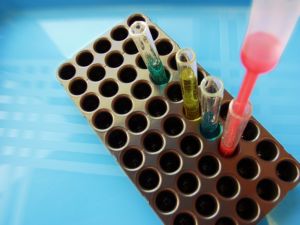- Conditional Probability
-
The conditional probability of an event \(A\) given that an event \(B\) has occurred is written:
\(P(A|B)\)
and is calculated using:
\(P(A|B)=\dfrac{P(A\cap B)}{P(B)}\)
as long as \(P(B)>0\).
Example 4-1 Continued Section

Let's return to our diagnostic test for renal disease. Recall that the researcher collected the following data:
| Test Results | |||
|---|---|---|---|
| Truth | Positive | Negative | Total |
| Renal Disease | 44 | 23 | 67 |
| Healthy | 10 | 60 | 70 |
| Total | 54 | 83 | 137 |
Now, when a researcher is developing a diagnostic test, the question she cares about is the one we investigated previously, namely:
If a person has renal disease, what is the probability of testing positive?
This quantity is what we would call the "sensitivity" of a diagnostic test. As patients, we are interested in knowing what is called the "positive predictive value" of a diagnostic test. That is, we are interested in this question:
If I receive a positive test, what is the probability that I actually have the disease?
We would hope, of course, that the probability is 1. But, only rarely is a diagnostic test perfect. The collected data suggest that the renal disease test is not perfect. How good is it? That is, what is the positive predictive value of the test?
Properties of Conditional Probability Section
Because conditional probability is just a probability, it satisfies the three axioms of probability. That is, as long as \(P(B)>0\):
- \(P(A|B)\ge0\)
- \(P(B|B)=1\)
- If \(A_1, A_2, \ldots, A_k\) are mutually exclusive events, then \(P(A_1\cup A_2\cup \ldots \cup A_k|B)=P(A_1|B)+P(A_2|B)+\ldots+P(A_k|B)\) and likewise for infinite unions.
The "proofs" of the first two axioms are straightforward:
The "proof" of the third axiom is also straightforward. It just takes a little more work:
Example 4-3 Section
A box contains 6 white balls and 4 red balls. We randomly (and without replacement) draw two balls from the box. What is the probability that the second ball selected is red, given that the first ball selected is white?
What is the probability that both balls selected are red?
The second method used in solving this problem used what is known as the multiplication rule. Now that we've actually used the rule, let's now go and generalize it!